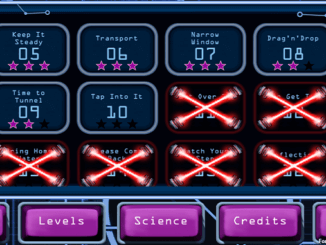
In a video game called Quantum Moves, the players’ goal is straightforward: Move an atom from one place to another as quickly and efficiently as possible while a timer counts down the seconds. Atoms in the game aren’t represented as mini solar systems with electron “planets” moving around them, like those you see in a middle-school textbook. Rather, they’re liquid-like waves sloshing in a roughly U-shaped curve. To move the atoms, players have to move the curve.
The antagonists in video games tend to be monsters or zombies, but Quantum Moves pits players against the fundamental laws of nature. The waves represent the changing probability distribution of the atom’s location, showing where it’s most likely to be measured. Players get points when they shuffle the waves into a designated location, and the more waves that get there, the more points players earn. But that’s tricky. The atom-waves slosh around, often high enough to splash out of the curve and disappear.
As levels advance, the atomic waves become less predictable: It’s harder to tell where they’ll move. Other quantum phenomena come into play, such as tunneling, which is the probability that a particle will pass through a solid barrier. On screen, that means the waves might vanish from one curve—and show up in another.
Quantum mechanics may be among the strangest and most abstruse subject matters in science. Its fundamental ideas are fussy, counterintuitive, and difficult to explain to the uninitiated. But Quantum Moves suggests there’s a way for amateurs to learn about those big ideas without struggling through years of formalism and equations. And it’s far from the only game with an ambitious outreach agenda.
Read the full article by Stephen Ornes on PNAS
http://www.pnas.org/content/115/8/1667
Strange Games
Designer Difficulties
Recruiting Players
Beyond Quantum


